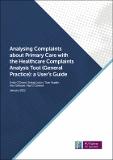Analysing complaints about primary care with the healthcare complaints analysis tool (General Practice): A user’s guide
| dc.contributor.author | O’Dowd, Emily | |
| dc.contributor.author | Lydon, Sinéad | |
| dc.contributor.author | Reader, Tom | |
| dc.contributor.author | Gillespie, Alex | |
| dc.contributor.author | O’Connor, Paul | |
| dc.date.accessioned | 2022-03-28T12:56:54Z | |
| dc.date.available | 2022-03-28T12:56:54Z | |
| dc.date.issued | 2022-01 | |
| dc.identifier.citation | O’Dowd, Emily, Lydon, Sinéad, Reader, Tom, Gillespie, Alex, & O’Connor, Paul. (2022). Analysing complaints about primary care with the Healthcare Complaints Analysis Tool (General Practice): a user’s guide. Galway: National University of Ireland. DOI: 10.13025/p8ac-nr86 | en_IE |
| dc.identifier.uri | http://hdl.handle.net/10379/17093 | |
| dc.description.abstract | General practice is a vital aspect of the health service, with large numbers of patient contacts every year1. While general practice is often seen as inherently less risky than secondary care2, errors have been found to occur in between 2–3% of consultations3. A recent study in Irish out-of-hours general practice found a complaints rate of 0.61 per 1000 consultations4. Patient complaints are an under-utilised source of data about quality of care. Typically, complaints are resolved on an individual basis by responding to the person who made the complaint and addressing their concerns.It is acknowledged that receiving a complaint can be a stressful, negative experience for healthcare providers5. It may be beneficial for a healthcare provider who has received a conplaint against them to liase with an indeminfier, who will be in a position to offer help, support, amd reassurance. However, research and policy is shifting towards reframing complaints from a negative experience, to using them as a valuable source of data to support quality improvement efforts. Until recently there has been a lack of valid and reliable systems for examing trends across complaints at a regional and/or national level6, but there are now valid and reliable tools for analysing complaints about hospital and general practice care.The Healthcare Complaints Analysis Tool (HCAT) was developed to systematically analyse complaints about secondary care. Information on the HCAT is available online7. However, while the HCAT is a suitable tool for analysing hospital complaints, it cannot be directly applied to analysing complaints about general practice. This guide outlines how to use the Healthcare Complaints Analysis Tool (General Practice) [HCAT(GP)] to analyse general practice complaints. The HCAT(GP) is based upon the original HCAT, but tailored specifically for general practice. Evaluations of HCAT(GP) have found that it is a valid and reliable tool for analysing complaints about general practice. | en_IE |
| dc.format | application/pdf | en_IE |
| dc.language.iso | en | en_IE |
| dc.publisher | National University of Ireland Galway | en_IE |
| dc.relation.ispartof | en | |
| dc.rights | CC BY-NC-ND 3.0 IE | |
| dc.rights.uri | https://creativecommons.org/licenses/by-nc-nd/3.0/ie/ | |
| dc.subject | Complaints | en_IE |
| dc.subject | Primary Care | en_IE |
| dc.subject | Healthcare Complaints Analysis Tool | en_IE |
| dc.subject | Healthcare complaints | en_IE |
| dc.title | Analysing complaints about primary care with the healthcare complaints analysis tool (General Practice): A user’s guide | en_IE |
| dc.type | Report | en_IE |
| dc.date.updated | 2022-03-21T10:23:09Z | |
| dc.identifier.doi | 10.13025/p8ac-nr86 | |
| dc.local.publishedsource | https://dx.doi.org/10.13025/p8ac-nr86 | en_IE |
| dc.description.peer-reviewed | non-peer-reviewed | |
| dc.internal.rssid | 27895941 | |
| dc.local.contact | Emily O'Dowd, -. - Email: emily.odowd@nuigalway.ie | |
| dc.local.copyrightchecked | Yes | |
| dc.local.version | ACCEPTED | |
| nui.item.downloads | 261 |


